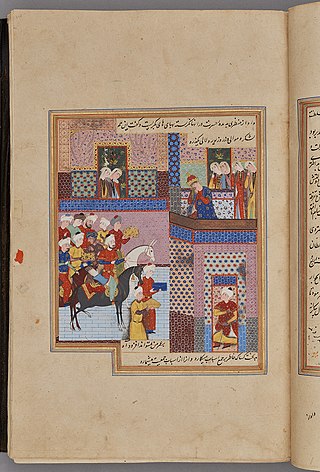Related Research Articles

The Anushtegin dynasty or Anushteginids, also known as the Khwarazmian dynasty was a Persianate Sunni Muslim dynasty of Turkic mamluk origin from the Bekdili clan of the Oghuz Turks. The Anushteginid dynasty ruled the Khwarazmian Empire, consisting in large parts of present-day Central Asia, Afghanistan and Iran in the approximate period of 1077 to 1231, first as vassals of the Seljuks and the Qara Khitai, and later as independent rulers, up until the Mongol conquest of the Khwarazmian Empire in the 13th century.

Ahmad Sanjar was the Seljuq ruler of Khorasan from 1097 until 1118, when he became the Sultan of the Seljuq Empire, which he ruled until his death in 1157.

'Alā' al-Din Muhammad was the Shah of the Khwarazmian Empire from 1200 to 1220. His ancestor was Anushtegin Gharchai, a Turkic Ghulam who eventually became a viceroy of a small province named Khwarizm. He was subjected to the Mongol conquest of the Khwarazmian Empire, which resulted in the utter destruction of his empire.

Mu'izz al-Din Muhammad ibn Sam, also known as Muhammad of Ghor or Muhammad Ghori, was a ruler from the Ghurid dynasty based in the Ghor region of what is today central Afghanistan who ruled from 1173 to 1206. Muhammad and his elder brother Ghiyath al-Din Muhammad ruled in a dyarchy until the latter's death in 1203. Ghiyath al-Din, the senior partner, governed the western Ghurid regions from his capital at Firozkoh whereas Muhammad extended Ghurid rule eastwards, laying the foundation of Islamic rule in South Asia, which lasted after him for nearly half a millennium under evolving Muslim dynasties.
The Ghurid dynasty was a Persianate dynasty of eastern Iranian Tajik origin, which ruled from the 8th-century in the region of Ghor, and became an Empire from 1175 to 1215. The Ghurids were centered in the hills of the Ghor region in the present-day central Afghanistan, where they initially started out as local chiefs. They gradually converted to Sunni Islam after the conquest of Ghor by the Ghaznavid ruler Mahmud of Ghazni in 1011. The Ghurids eventually overran the Ghaznavids when Muhammad of Ghor seized Lahore and expelled the Ghaznavids from their last stronghold.

Taj al-Din Yildiz was a Turkic ghulam of the Ghurid dynasty, who, after the death of Sultan Muhammad of Ghor, became the de facto ruler of Ghazni, while, however, still recognizing Ghurid authority.
Altuntash was a Turkic Khwarazmshah from 1017 until his death in 1032.

Ghiyath al-Din Muhammad, also known as Ghiyath al-Din Ghori or Ghiyassuddin Ghori born, Muhammad, was the Sultan of the Ghurid dynasty. During the diarchy of Ghiyath and his younger brother Muhammad of Ghor, who governed the eastern realm of the Ghurid Empire, the Ghurids emerged as one of the greatest powers of the eastern Islamic world.

Muhammad II ibn Mahmud was Sultan of Seljuq Empire from 1153 to 1159. He was son of Mahmud II and brother of Malik-Shah III. The Cambridge History of Iran notes that Sultan Muhammad "tried energetically to restore the slipping authority of his dynasty in Iraq".
Ala al-Din Husayn was king of the Ghurid dynasty from 1149 to 1161. He was one of the greatest Ghurid kings, and it was during his reign that the Ghurid dynasty rose to prominence.
Sayf al-Din Suri was the king of the Ghurid dynasty from 1146 to 1149. He was the son and successor of Izz al-Din Husayn.
Baha al-Din Sam I, was the king of the Ghurid dynasty who reigned briefly in 1149. He was the brother and successor of Sayf al-Din Suri.
Sayf al-Din Muhammad was the king of the Ghurid dynasty from 1161 to 1163. He was the son and successor of Ala al-Din Husayn.

Ghiyath al-Din Mahmud, was Sultan of the Ghurid Empire from 1206 to 1212. He was son of Ghiyath al-Din Muhammad the nephew of Muhammad Ghuri whom he succeeded in 1206.
Ala al-Din Atsiz, was Sultan of the Ghurid dynasty from 1213 to 1214. He was the relative and successor of Baha al-Din Sam III.
Fakhr al-Din Masud, was the first ruler of the Ghurid branch of Bamiyan, ruling from 1152 to 1163.
Ala al-Din Aliibn Shuja al-Din Mohammad, also known as Zia' al-Din Ali, was the last Sultan of the Ghurid dynasty from 1214 to 1215. He was the cousin and successor of Ala al-Din Atsiz.

Jalal al-Din Ali was the last ruler of the Ghurid branch of Bamyan, ruling from 1206 to 1215.
Izz al-Din Husain ibn Kharmil al-Ghuri, commonly known after his father as Ibn Kharmil, was an Iranian military leader of the Ghurid dynasty, and later the semi-independent ruler of Herat and its surrounding regions.

Baha al-Din Sam II was the fourth ruler of the Ghurid branch of Bamiyan, ruling from 1192 to 1206.
References
- ↑ The Iranian World, C.E. Bosworth, The Cambridge History of Iran, Vol. 5, ed. J. A. Boyle, John Andrew Boyle, (Cambridge University Press, 1968), 161-170.
